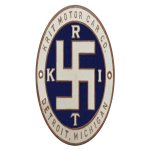I think the nazi swastika is almost always "tilted" - 45 degrees - as if "standing" on a point; whereas the various other uses of the symbol are almost always "square" - standing on a flat arm. The symbol might be the same element, but oriented differently?
From Wikipedia, apparently is known to be "right hand" and "left hand" versions - as shown on OP's first picture, I think those are "right hand" - the top bar extends to right - is also known versions where that same top bar extends to the left.
A parallel that I am aware of - on Swede military rifles - the Swede Crown stamp - when vertical, that arm (or part) was made by the Carl Gustaf Armoury - when tilted (same stamp), that part was made by a sub-contractor - often Husqvarna. Same symbol / stamp used - just different meaning conveyed, depending on the orientation of it. I have lost track, but I think sometimes tilted 45 degrees to right, sometimes tilted 45 degrees to left - I do not recall if there is any significance to the direction of the "tilt" of that Swede crown.













































































